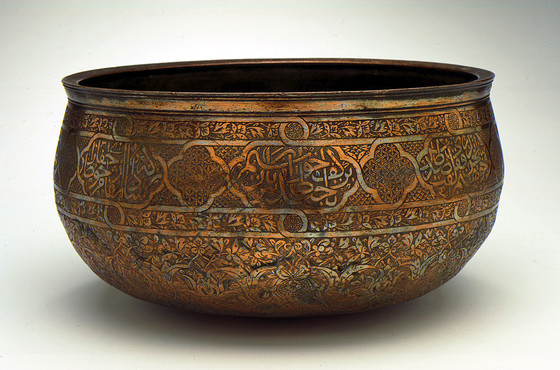...
This bowl belongs to what is arguably one of the most brilliant periods in Persian art, the reign of the Timurid Sultan-Husayn Bayqara (1470-1506). Sultan-Husayn's court attracted the preeminent artistic and literary talents of the day, and Herat (in modern Afghanistan), the Timurid capital, was the focal point of this cultural efflorescence. The Timurid court is best known for the arts of the book, but the decorative arts, including metalwork, also flourished there. The museum's bowl, the decoration of which combines lush floral ornament and handsome calligraphy, typifies the artistic milieu of the period. Made of almost pure copper, the bowl was originally tinned, which produced a silvery surface that is only partially preserved. Because tin is highly resistant to organic acids, it was frequently used on the interiors of food and beverage receptacles to protect both vessel and owner. Beginning in the Timurid period, the exteriors of bowls and other objects were often tinned as well, but for a purely coloristic effect and perhaps to emulate actual silver. The bowl's boldly drawn floral and vegetal designs are among the numerous distinctive features that relate this vessel to a small group of high-quality tinned copper wares, two examples of which are dated to the year 902/1497-98. Many of these motifs, as well as the rigid symmetry of the ornament, are illustrated in a series of 15th century drawings that may have served as patterns for Timurid artists. This could explain the recurrence of the same floral and vegetal designs in nearly all contemporary media, including manuscript illuminations, bookbindings, textiles, woodwork, and stone carvings. Along with the floral ornaments, a Persian poem, in four couplets, contained within a series of eight cartouches dominate the bowl's decoration:
My ear discerned a voice reverberating from the bowl:
"I drew and made a thousand designs for the sake of the bowl."
Seeking what is hidden on our lips
We want to say one hundred words into the bottom of the bowl:
"How long will he find his useless presence in the palm of the silver-breasted beauties?"
Alas, such is the cruelty of the bowl.
Fill the bowl with clear wine, O Sage
And then experience the bowl with your searching gaze.
It seems likely that the poem was written specifically for the object to which it appears to give voice—the bowl. It is referred to as a tas (bowl), which is used as the fixed end rhyme, while its presumed function is as a receptacle for wine, as in the fourth couplet. The repetition and multiplicity of the same designs as on the bowl in contemporaneous drawings recommends that the verse "I drew and made a thousand designs for the sake of the bowl" is not entirely hyperbolic but rather is indicative of a specific creative practice in Timurid ateliers.
For more information on this bowl, see this
video.




